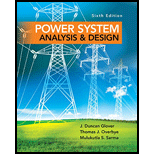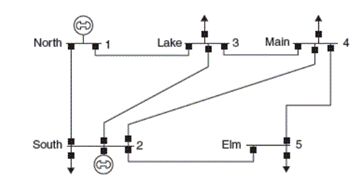
Power System Analysis and Design (MindTap Course List)
6th Edition
ISBN: 9781305632134
Author: J. Duncan Glover, Thomas Overbye, Mulukutla S. Sarma
Publisher: Cengage Learning
expand_more
expand_more
format_list_bulleted
Concept explainers
Textbook Question
Chapter 6, Problem 6.30P
Determine the bus admittance matrix

TABLE 6.11
Bus input data for Problem 6.20

TABLE 6.12
Partially Completed Bus Admittance Matrix
Expert Solution & Answer
Trending nowThis is a popular solution!

Students have asked these similar questions
show work
Zgktztistizttsittkskstsgk
W=10,000 if you can answer b and c
Chapter 6 Solutions
Power System Analysis and Design (MindTap Course List)
Ch. 6 - For a set of linear algebraic equations in matrix...Ch. 6 - For an NN square matrix A, in (N1) steps, the...Ch. 6 - Prob. 6.9MCQCh. 6 - Prob. 6.11MCQCh. 6 - Using Gauss elimination, solve the following...Ch. 6 - Prob. 6.9PCh. 6 - Determine the bus admittance matrix (Ybus) for the...Ch. 6 - Prob. 6.34PCh. 6 - Prob. 6.37PCh. 6 - Prob. 6.38P
Knowledge Booster
Learn more about
Need a deep-dive on the concept behind this application? Look no further. Learn more about this topic, electrical-engineering and related others by exploring similar questions and additional content below.Similar questions
- Solve on paper not using AI or chatgptarrow_forwardPractice1 A single-phase step-down transformer of 83 kVA, nominal voltages 24kV/230 V, frequency 60 Hz is available.The following test parameters are available:Pfe = 216 W, Io = 2% Pcc = 1083 W, Vcc = 4% Determine:a. Parameters Rcc, Xcc and Rfe of the equivalent circuit referring to the secondary.b. Relative voltage drops. εcc, εrcc, εxccarrow_forwardA single-phase step-down transformer of 83 kVA, nominal voltages 24kV/230 V, frequency 60 Hz is available.The following test parameters are available:Pfe = 216W, Io = 2%, Pcc = 1083W, Vcc = 4% Determine: If the transformer is connected to 24 kV, a load Zc, fp = 0.866 in arrears, is installed in the secondary transformer, which consumes the nominal current. Calculate:• Transformer voltage regulation (perform calculations by PU's)• Maximum efficiency.arrow_forward
- The magnetic circuit shown in the figure is made of TRAN-COR material, the flow magnetic power on the right arm (BCDE) is 6 x 10 -4 Wb. (disregard marginal effects anddispersion) Calculate the current in the 200-turn coilarrow_forwardtheoretically and compare it with the test value. Report :- 1- Calculate the D.C. output Voltagearrow_forwardf 2- For resistive load, measured the output voltage by using oscilloscope, then sketch this wave.. 3- Measure the average values of Vɩ and Iɩ . 4- Repeat steps 2 & 3 but for R.L load.arrow_forward
- A single-phase 10 kVA, 1000/100V transformer has the relative voltage parameters of: εrcc = 6%, εxcc = 8%, core losses Pfe = 200W and nominal copper losses of Pcu = 300W.A load of 2 < 30° Ω is connected to the secondary of the transformer. Determine using pu ́s calculations:to. The voltage in the primary, if the voltage of the secondary (at load) is 100 V.b. If the voltage in the primary remains constant at 1000 V, what would be the voltage at the load?c. The voltage regulation of the transformer under the conditions b.d. The efficiency of the transformer under the conditions b.arrow_forward9.38 For the op-amp circuit of Fig. P9.38:(a) Obtain an expression for H(w) = Vo/Vs in standard form.(b) Generate spectral plots for the magnitude and phase ofH(w), given that R1 = 99 kW, R2 = 1 kW, and C = 0.1 μF.(c) What type of filter is it? What is its maximum gain?arrow_forwardA short 3-o transmission line with an impedance of (6+j 8)2 per phase has receiving end of 22000 kw, 120 KV, 0.8 lagging p.f. Determine (i) Sending voltage (ii) Sending current (iii) Sending power factor (iv) voltage regulation.arrow_forward
- 9.37 For the op-amp circuit of Fig. P9.37:*(a) Obtain an expression for H(w) = Vo/Vs in standard form.(b) Generate spectral plots for the magnitude and phase ofH(w), given that R1 = 1 kW, R2 = 4 kW, and C = 1 μF.(c) What type of filter is it? What is its maximum gainarrow_forwardI need a detailed drawing with explanation Solve es 4 = -20125 شكا +981X914 pv + 96852 الإنجليزية (second order differential I need an example on the subject the partition method and the Laplace method. Suggest an easy equations) and you solve it using and simple example for me and solve it using two methods, only one example. 750 01 95Parrow_forwardNot use ai pleasearrow_forward
arrow_back_ios
SEE MORE QUESTIONS
arrow_forward_ios
Recommended textbooks for you
 Power System Analysis and Design (MindTap Course ...Electrical EngineeringISBN:9781305632134Author:J. Duncan Glover, Thomas Overbye, Mulukutla S. SarmaPublisher:Cengage Learning
Power System Analysis and Design (MindTap Course ...Electrical EngineeringISBN:9781305632134Author:J. Duncan Glover, Thomas Overbye, Mulukutla S. SarmaPublisher:Cengage Learning

Power System Analysis and Design (MindTap Course ...
Electrical Engineering
ISBN:9781305632134
Author:J. Duncan Glover, Thomas Overbye, Mulukutla S. Sarma
Publisher:Cengage Learning
How do Electric Transmission Lines Work?; Author: Practical Engineering;https://www.youtube.com/watch?v=qjY31x0m3d8;License: Standard Youtube License